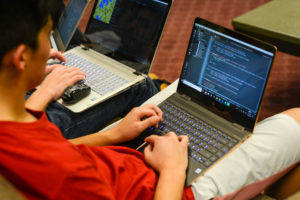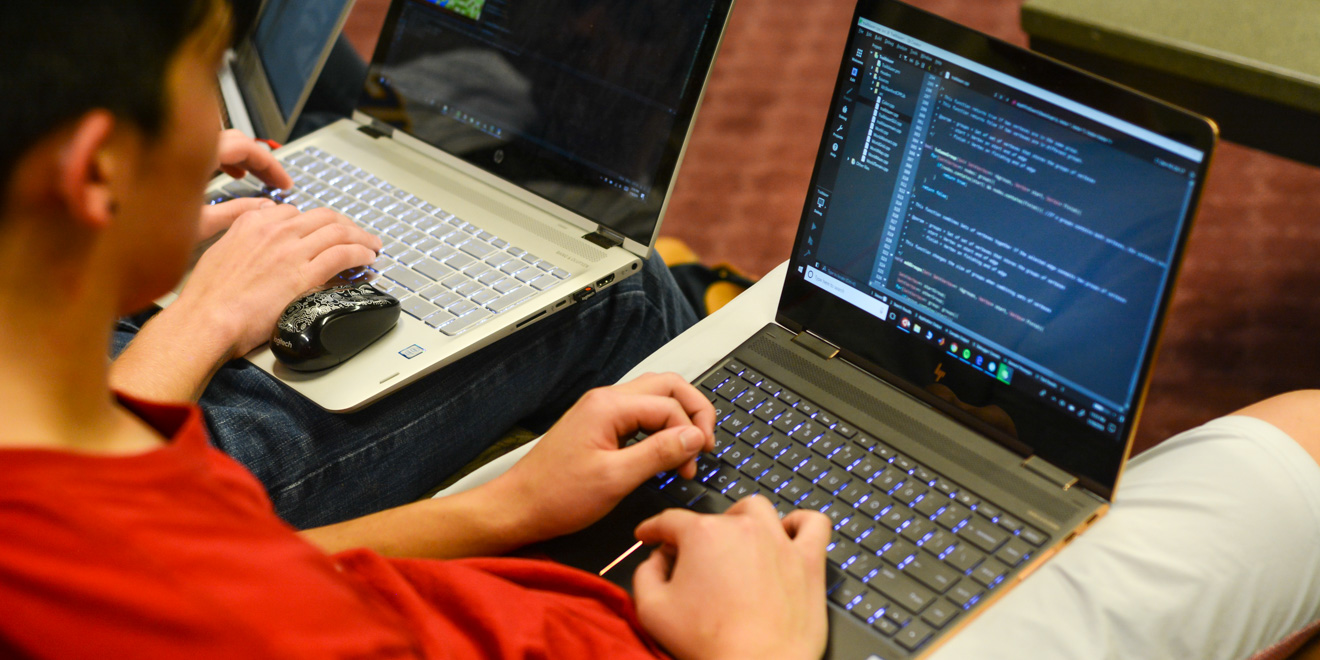As students continue to flock to computer science, Stanford’s CS department has to grapple with the challenges of hosting the most popular major on campus.
With introductory courses drawing hundreds of students and some upper-division classes drawing close to a thousand, challenges range from crowded office hours to ensuring the quality of large-scale teaching while creating an individual experience for each student.

CS has surged in popularity at Stanford within the last decade, although a previously rapid increase has gradually begun to slow down.
In a Daily article published in 2015, Computer Science professor Eric Roberts said the number of CS degrees issued in the 2013-14 academic year was more than triple the number issued in 2008-09. In addition, the number of students declaring CS as their major has grown more than 300 percent in the last decade, in what Roberts called indicative of a “revolutionary change.”
“The trend has been going on for quite a while, and it’s a national trend so many schools are seeing increases in computer science,” said computer science professor Mehran Sahami ’92 MS ’93 PhD ’99, the department’s associate chair for education. “Stanford is ahead of the curve. We started seeing increases earlier than other people did. But the national phenomena has carried that forward even more.”
This increase in popularity has now leveled out. As of fall quarter of this school year, there were 663 total undergraduates enrolled in the major, similar to the 661 enrolled in fall quarter of the 2015-16 academic year.
“The enrollment in [introductory sequence CS] 106 this year is actually comparable to some of its previous years,” Sahami said. “But it follows a pattern; enrollment in the 106 classes have just in general been increasing pretty much every year for the last 10 years. The increase this year is in line with what we would have expected.”
Although growth in the popularity of CS has begun to slow down, the number of students enrolled in this program continues to surpass all other majors. Human Biology is the second largest major at Stanford, and in the fall quarter of 2016, there were 240 students enrolled in the program. That’s 423 less than the number enrolled in the CS program during the same quarter.
This vast number of students presents the challenge of organizing large classes and ensuring that the quality of teaching is maintained on a bigger scale. Most CS classes do not have an enrollment cap.
“The challenge for us is just to be able to provide a quality education at scale,” Sahami said. “Some things scale more easily than others. I think that’s the big challenge — dealing with issues of quality feedback at that scale.”
“If you’re a smaller organization, it is easier to innovate, but in a big class, you innovate less because if something goes a little wrong, there are much bigger consequences,” said Rickard Gabrielsson ’15, a current CS 221 TA and first-year master’s student. “I think we would like to innovate and change more, rather just trying to get something that works well and take the safe options. You tend to optimize for the general experience.”
An unusual aspect of the CS department is upper-division classes that continue to have similar sizes to introductory classes and even surpass them. This year, two particularly large upper-division classes include Artificial Intelligence (CS 221) and Machine Learning (CS 229).
“We have some classes like Machine Learning, which has become a very hot topic, not just in computer science but across many disciplines — [it] has over 900 students,” Sahami said. “The Artificial Intelligence class, which has also become a very hot area, has over 800 students.”
Large class sizes in these upper-division courses may influence teaching methods and styles, particularly in finding ways to engage students more critically with the material. It also presents the challenge of finding a balance between mass-teaching material while tailoring an individual experience for each student that is often the goal of upper-level courses.
“We’re pretty good at teaching the paradigm,” Gabrielsson said. “But it’s harder to get people to think critically about what they’re learning, questioning and getting their own unique perspective on the material, which I think is very necessary. We want students to not become machines that are mass-produced, but, especially in upper level, to enforce their own understanding. I think that’s getting even harder as classes grow.”
One side-effect of larger classes is the volume of honor code cases some instructors have had to grapple with. For instance, the teaching staff for the latest offering of CS 229 were uncertain about how to handle the inordinate number of suspected honor code violations that they found while grading the third problem set.
Because the potential violations were so extensive, instructors initially planned to handle the cases by deducting points for suspected violations rather than notifying the Office of Community Standards (OCS). Head TA Anand Avati wrote that the TAs had noticed that many assignments bore suspicious similarities to previous years’ solutions, skipping crucial mathematical steps, but that there were “far too many [honor code violations] to report [to OCS].”
Later in the day, CS 229 course coordinator and department program manager Swati Dube sent out a correction stating that they would revert the point deductions and notify OCS in compliance with the honor code.
“We are not deducting any points based on suspicion of honor code violations, and we plan to report all suspected violations as we always do,” Dube wrote. She described the original post as a “mistake” in an email to The Daily.
One student in CS 221 last fall said the increase in class sizes has made complying with the honor code more challenging for students as well. The student, who asked to stay anonymous, said that the long lines at instructors’ office hours lead many students to seek more hands-on help from their peers instead – behavior which can count as “unpermitted collaboration” under the honor code.
“It is impossible to do this while 100 percent abiding by the Honor Code,” the student said. “There is just no way to stay sane and get through this without the help of your peers because the lines at office hours take way too long. If you need help, you need help and office hours can’t provide that unless you have three or four hours to wait.”
She described a certain time in which section leaders opened up the queue for thirty seconds at the beginning of an allotted time and then closed the line to work through the number of students who had signed up during this time.
“They imposed the restrictions because the site they were using was crashing from too many users, so they restricted the signups rather than adding more [course assistants] usually,” said the same student. “They sent out a survey midway through the quarter asking how they could improve the site (queuestatus) but I don’t know what became of it.”
Apart from honor code violations, instructors and students agree that the combination of large classes and limited teaching staff have made it tougher to get help at office hours.
“We have to cancel the queue early before the office hours are over, so there are students who want to get help but don’t get help,” Gabrielsson said. “If there’s like 50 people in line, I can’t spend one hour with one student, because then I’m only helping one student. That’s something we could optimize more.”
Students concurred that overcrowded office hours detract from the student experience.
“I try to avoid the LaIR as much as possible because I hear so many horror stories about waiting for two hours,” said Aarthi Popat ’21, a current 106A student, referring to the help hours available to beginning CS students in Tresidder Union.
Such challenges have encouraged professors and TAs to create new methods aimed at ensuring each student receives the necessary help — for example, by adopting online tools, including online office hours.
“There’s a lot of infrastructure to help,” Gabrielsson said. “We have online office hours where we can video-chat with students; we’re also getting better at holding group office hours. So if a lot of people have the same question, we can address it in a big group.”
Online office hours involve a similar queue to in-person ones and supplement video conversations with a virtual whiteboard to draw on, Gabrielsson explained.
“It is different to teach over video form rather in person, but you get better at it,” he said.
Aware of the popularity of CS at Stanford, the department administration is “working really hard to maintain these enrollments while still providing … a high-quality education,” according to Sahami.
“There are ways we could easily solve that problem: we could limit enrollment, we could limit access to the major.” Sahami said. “But we don’t want to do that because we want to give students the freedom to major in what they like or take the classes they want.”
Others also emphasized that the CS department does not seek to turn students away.
“I get the sense that we know or we expect that every quarter, enrollment will go up,” Kush Khosla ’19, a CS 106B section leader said. “We’re prepared for it and we welcome it.”
However, according to Júlio Mendes, a graduate student currently enrolled in CS 229, the significant increases in enrollment contribute to honor code violations. Mendes believes the hype surrounding machine learning attracts tremendous student interest, even if students don’t have necessary prerequisite knowledge.
“Because not everyone has the prerequisites, some people decide to take the easy path and cheat to still get a good grade for future job applications,” Mendes said. “My opinion is that the honor code is crucial. Prerequisite checks are also crucial. The lack of the latter can very often lead to the former … An effective solution starts in the beginning of the quarter, by the enrollment date.”
The CS 229 case was not the first time honor code violations have been widely suspected in CS courses. In 2015, CS 106A saw over over 100 violations reported, prompting a letter to all faculty from former Provost John Etchemendy Ph.D. ’82.
“What makes me sad is the fact that by now, instructors are aware of the issue, yet they repeat the problem sets year after year, ” Mendes said.
However, Gabrielsson said he has faith in the ability of the CS department to overcome the challenges posed by significant enrollment increases on the whole.
“In general, I’m very impressed with all the work of the professors, the course assistants and the CS students,” he said. “I think that with technology and changing trends, we are able to handle these big classes.”
Hannah Knowles contributed to this report.
Contact Arielle Rodriguez at arielle3 ‘at’ stanford.edu. Contact Elaine Park at elainep ‘at’ stanford.edu. Contact Alex Tsai at aotsai ‘at’ stanford.edu.
